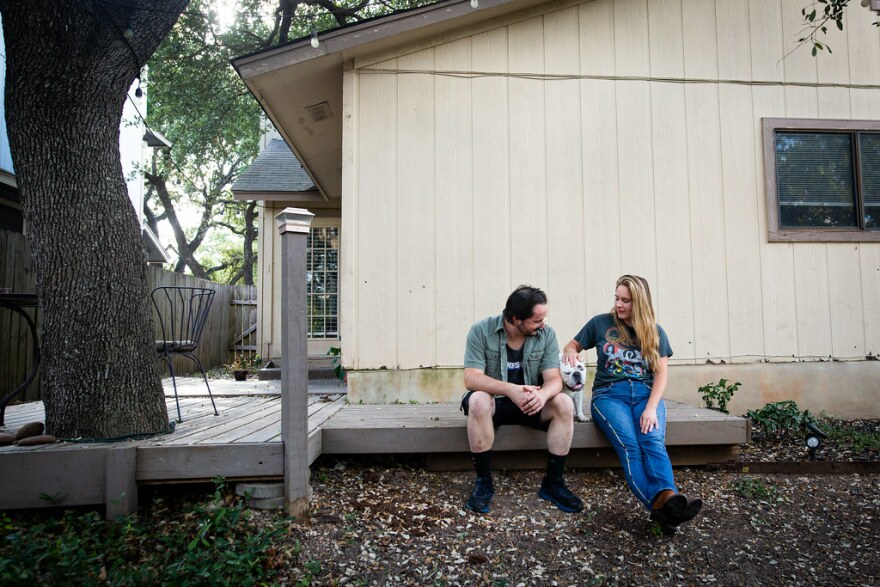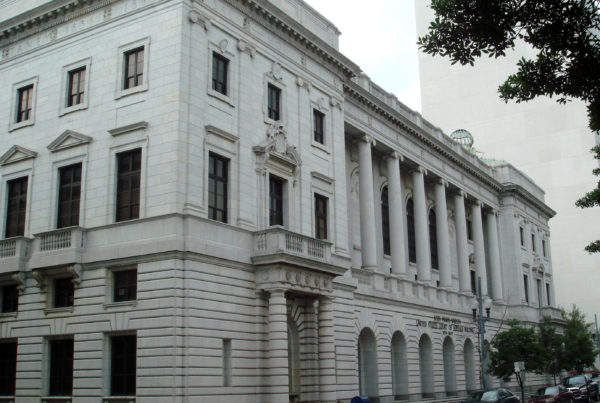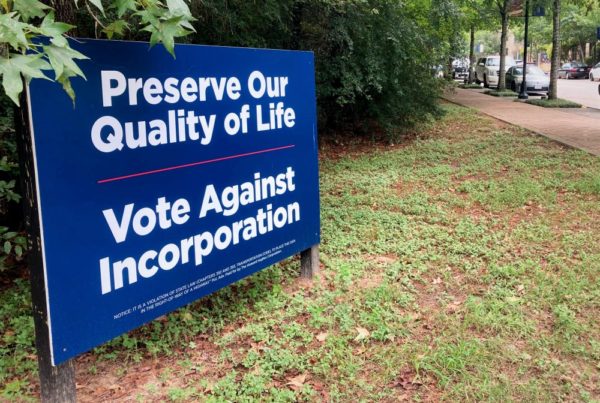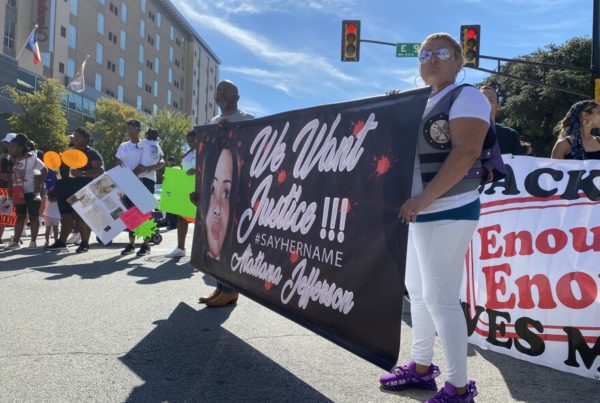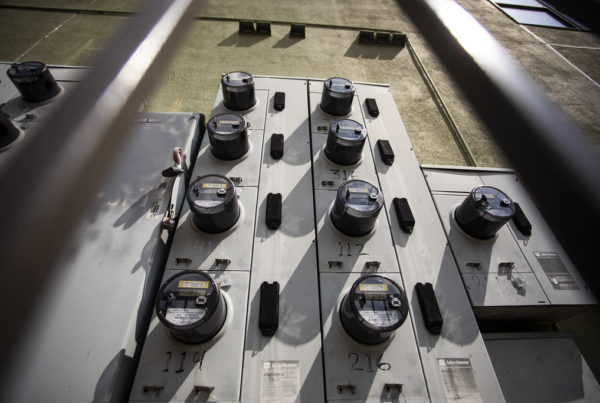From KUT:
Elisa Regulski was getting desperate. The 29-year-old’s lease on an apartment in South Austin was days away from ending, but after putting in half a dozen applications she still didn’t have a place to move.
“I wasn’t sleeping very well,” she said. “If you were to ask my friends, they would say that was pretty much all I was talking about for that month.”
Then Regulski, who was looking for a place with her fiancé, got some advice that typically gets doled out only to would-be homebuyers in Austin’s booming housing market: offer to pay more than the asking price.
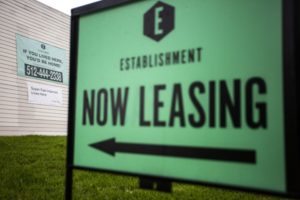 “In a last-ditch effort, our realtor was basically saying that people were bidding — maybe $200 to $300 over rent a month,” she said. “That was shocking.”
“In a last-ditch effort, our realtor was basically saying that people were bidding — maybe $200 to $300 over rent a month,” she said. “That was shocking.”
Regulski and her fiancé, Mark Moore, felt they had no other option. When they found a three-bedroom rental home in South Austin listed for $1,800 a month they offered to pay $2,000. In return, they got a 12-month lease — a win that didn’t quite feel worth celebrating.
“It feels like a scam,” Regulski said.
Rent prices in Austin have been increasing at the fastest rate ever, according to several data analysts that track this information. The culprit? Experts say the supply of homes and apartments for rent is not keeping up with the number of people who want to live in them.
This imbalance, the effects of which are evident in the for-sale market, means prices have ballooned. While rents in Austin have typically increased by up to 5% each year, this past year they have risen nearly 20%, according to some numbers.
“We’ve been tracking the market for 28 years now,” Robin Davis, manager of Apartment Trends, said. “And we’ve never seen this kind of increase.”
A migration to Austin
Rent prices in Austin fell during the height of the pandemic; in November, the average monthly rent dropped to $1,259, according to numbers from RealPage Analytics.
But since then, rent has rocketed up and at a historic rate. The average price of rent hit $1,511 in August, which represents a 18% increase over the year before.
Prices have been getting so high that Maddie Hastings, whose job it is to get people to sign new leases, has been advising people to do the opposite.
“I’ve had to tell quite a few people I really think you should renew [your lease], because you’re going to be paying more for something that’s not as nice,” she said.
Hastings, an apartment locator for Smart City, said apartment complexes often use an algorithm to calculate rent prices depending on the number of applications they’re getting — that is, how much interest they’re seeing.
“It has to do entirely with supply and demand,” she said. “Let’s say that unit was going for $2,500. All of a sudden that apartment complex gets five applications in a week. … Overnight the prices are automatically going to update to reflect new, more expensive pricing because they can see the demand is high.”
Experts say this demand is fueled by people moving to Austin from out of town. Since 2010, about 32,000 people a year have moved to the city from other parts of the U.S., according to an analysis by the Austin Chamber of Commerce.
While new migration data has not yet been released by the U.S. Census Bureau, people who work in the housing market say anecdotally that annual count of people migrating here has likely increased — and they’re coming from more expensive cities.
“I get a lot of people coming from New York, East Coast or California,” Hastings said. “A lot of them are expecting Austin to be so much cheaper.”
And while Austin rents are still lower than those in San Francisco or New York City, the people moving from these cities may be bringing higher salaries with them, said Ali Wolf, chief economist at the housing market research company Zonda.
“You have an inflow of people who probably have a lot of money or a higher wage than the local wage,” she said. “That can allow for rents to go up, as well.”
Wolf said another factor may be the fact that people who are able to work from home are looking for more space and, if they can afford it, are separating from roommates to find their own place — putting additional strain on the city’s stock of places to rent.
But, Wolf said, there may be some relief on the horizon.
“If you want more news, there is so much development occurring,” she said. “It just takes time.”
A flood of new rental units
While demand for housing in Austin is high, construction hasn’t entirely slowed. It’s actually begun to bustle.
Since 2014, a median of about 5,700 new rental units have been added to the city each year. Austin is on track to eclipse that this year; in the first half of 2021, just over 4,000 new homes became available to rent, according to data from Apartment Trends.
“I think that we will complete more units this year than we have ever completed before,” said Charles Heimsath, president of the real estate research firm Capitol Market Research. He also said 2022 could be another record-setting year, with even more apartment complexes finishing construction and more units becoming available to rent.
Even with a flood of new rental units being built, none of the data indicates Austin is meeting the demand of renters. Units are getting filled quickly.
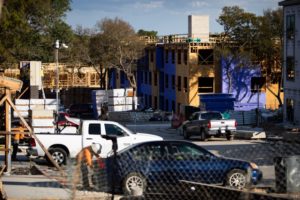
Construction of new apartment complexes is booming in Austin. In the first half of 2021, just over 4,000 new homes became available to rent.
Gabriel C. Pérez
Real estate experts measure the demand for housing with what’s called absorption, or the number of rental units that are occupied each year. So far this year, the number of apartments “absorbed” has bypassed the number of new units built.
“We’ve absorbed more [homes] than were added,” said Davis. “So that’s telling you that the demand is higher than supply, and it's higher by a lot.”
Unless something changes, the result is, well, rapidly increasing rent prices.
“Without a doubt, it is the fastest growth rate in the last six or eight months that we've experienced at any time, as long as I've been tracking growth in Austin, which has been some 25, 30 years,” Heimsath said.
“Just so upset and so mad.”
Hannah Willis earns $15 an hour doing data entry for the job-listing site Indeed. It’s the highest-paying job the 24-year-old has ever had.
“I was a server,” she said. “I bussed tables for a while. I was also a barista.”
Since Willis moved to Austin from Phoenix three years ago, she’s been renting an apartment on the edge of North Austin, near Cedar Park, with a friend from her hometown.
Recently, that friend moved back to Arizona because she could no longer afford to live in Austin. The lease is up at the end of the month, but Willis said she can’t afford to stay — even if she were to find a new roommate.
“It’s a $1,200, two-bedroom, two-bath, and we couldn’t even re-up the lease here because they raised our rent to $1,700 [a month],” Willis said. “So, we’re literally getting pushed out of our apartment complex.”
Willis began looking for a new place this summer with her partner. The two were hoping to rent a two-bedroom for about $1,300 a month, a price that proved tricky to find in Austin.
After some hunting, they found an apartment in their price range in North Austin. But they weren't able to see the apartment they were interested in renting; the complex was so full, management could only let them see a similar one.
When Willis and her partner showed up for a walk-through, they got another surprise.
“We got in and they told us that the prices had already gone up,” Willis said.
In a week, the price had increased from $1,335 a month to $1,445 a month. It was more than they could afford.
Willis sat down in the model apartment, exasperated.
“I was just so upset and so mad," she said. "It felt so impossible to even just get a two-bedroom within me and my partner’s price range. ... This time a year ago, it was so much easier for me to find a place.”
Got a tip? Email Audrey McGlinchy at audrey@kut.org. Follow her on Twitter @AKMcGlinchy.


